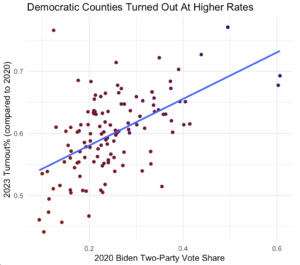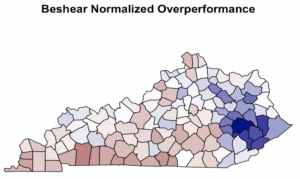Amid a climate of deepening divisions and staunch partisanship, Governor Andy Beshear’s re-election as a Democrat in Kentucky strikingly defies the prevailing political currents. Prediction markets and polling throughout the year favored Beshear over Republican Attorney General Daniel Cameron, so it would be inaccurate to call the result an upset. But as the results came in on Tuesday night, most of us could not help but watch in amazement as Beshear comfortably won re-election in the deep red state. Cameron tried his best to nationalize the race, releasing ads touting his endorsement from former President Donald Trump and bashing Beshear for supporting President Joe Biden’s agenda. Trump defeated Biden by a 62%-36% margin in Kentucky in 2020, winning all but two of the state’s 120 counties. Beshear won 29 counties on Tuesday and ran over 16% ahead of Biden on the way to a 53%-47% victory. Many attributed Beshear’s original victory in 2019 to the weaknesses of his opponent, Republican Governor Matt Bevin. But his win in 2023 dwarfed his performance in 2019, as he expanded his margin of victory from 5k to 67k votes. He will soon be one of three Democratic governors in states that Trump won in 2020, joined by Laura Kelly (Kansas) and Roy Cooper (North Carolina). The number of crossover Governors has declined steeply during the past decade as presidential and down-ballot results have been increasingly correlated.
Beshear Enjoyed a Dominant Turnout Advantage
Enthusiasm among Kentucky Republicans was low last Tuesday, while Kentucky Democrats turned out at incredible numbers for an off-year election. Beshear’s robust spending advantage can explain part of this turnout advantage, as he outspent Cameron by a $45-$26 million margin. Kentucky is a vast state that comprises ten separate media markets, and Beshear’s spending advantage is especially evident in the Evansville media markets. Turnout percentage in the 2023 Gubernatorial election (relative to the 2020 Presidential election) has a clear positive correlation with partisanship, as more Democratic counties turned out at much higher rates than Republican counties. This continues the theme of Democrats winning off-cycle elections in the Trump era, fueled primarily by their gains with high-education voters in the post-Trump era. Fayette (Lexington) and Jefferson (Louisville), the two leading Democratic vote population bases in Kentucky, turned out at especially robust rates, placing 7th and 12th out of the state’s 120 counties. DDHQ estimates that 79% of Biden voters in 2020 turned out to vote, while only 53% of Trump voters voted in the 2023 Kentucky Governor election. Beshear’s ability to win over Trump voters has captured a lot of press, but many of them just sat this race out. This turnout gulf helped propel Beshear to victory, something he could not have achieved with persuasion alone. Without this substantial turnout advantage, Beshear would have lost handily.

Beshear Pursuaded Trump Voters to Support Him Over Cameron
While Trump fully supported Cameron, his 2020 voters were more split in their preferences. DDHQ estimates that Beshear won the support of 93% of Biden voters on Tuesday, while Cameron won just 82% of Trump voters. Since Beshear flipped so many Republicans and Democrats turned out at such a high rate, he won more votes than Biden in 87 of Kentucky’s 120 counties despite overall turnout only being at 63% of 2020 levels. He outran partisan benchmarks by the most in the state’s ancestrally Democratic eastern portion, dominated by the coalfields and the Appalachian Mountain range.

Bottom Line
Beshear’s victory emerged from a potent combination of voter persuasion and positive turnout differential. Despite President Biden’s 26% deficit in Kentucky, Beshear achieved a 6% win, translating to a remarkable 32% shift in margin. Analysis by DDHQ estimates that this swing was driven equally by turnout and persuasion improvements. Specifically, DDHQ estimates that turnout differences drove 50.2% of the swing, while persuasion drove 49.8%. Counterfactual scenarios reveal that altering either variable independently—holding persuasion to 2020 levels while varying turnout to 2023 levels or vice versa—would have resulted in a loss for Beshear. Thus, his triumph necessitated success in both facets of the election.

Methodology
To evaluate the likelihood of individual voter behaviors in the 2023 Kentucky Gubernatorial Election—particularly whether voters chose Beshear, Cameron, or did not vote—the researcher used a Goodman Ecological Regression analysis, conditioning the analysis on the individuals’ voting patterns in the 2020 Presidential Election.
This method involves using Goodman’s Ecological Regression to derive estimates of the conditioned probabilities, with the analysis weighted according to the size of each county. This approach aims to offer insight into voter behaviors by examining the relationships at the group level, assuming that the voting patterns observed in the larger counties exert a greater influence on the overall probability estimates. The analysis also assumes a static voter population, meaning it is presumed that all voters in the 2023 Kentucky Governor’s Election had also cast a ballot in the 2020 Presidential Election within Kentucky.